About creating constants in JavaScript (detailed tutorial)
This article mainly introduces the relevant knowledge points about creating constants in JavaScript to help you learn more about JS. Please refer to it.
This article conducts an in-depth analysis of the definition and usage of constants in JS and common errors in function writing. I hope it will be useful to everyone:
The so-called constants can only be read but not edited (delete , modified) variables.
js does not have the original constant statement (that is, customized, original), but it can be created in some remote ways.
1: const declaration keyword in es6.

#The two variables are declared above, and an error will be reported when the modification operation is performed. To some extent, const can create variables (basic types). But reference types are hard to come by.
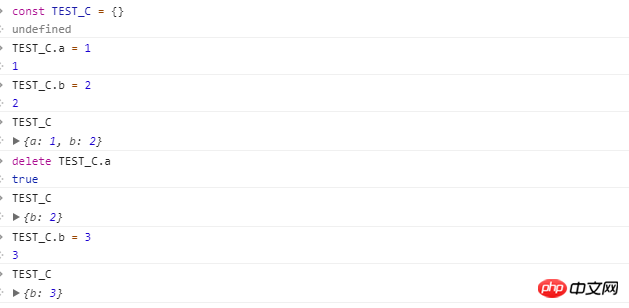
#When the declared variable is a reference type, it is an object, and operations on the object (deletion, modification, addition) can be performed.
2: Object method (defineProperty, seal, freeze) implementation
1) Object.defineProperty: This method will directly define a new property on an object, or modify the existing property of an object properties, and returns this object.
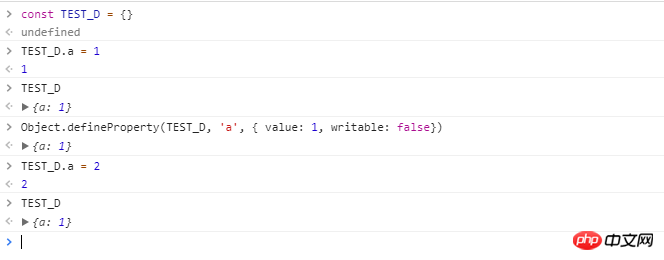
#After using the above method, the subsequent modification function of a will be invalid. Although the modification function cannot be executed normally, the deletion function can still be performed as usual.

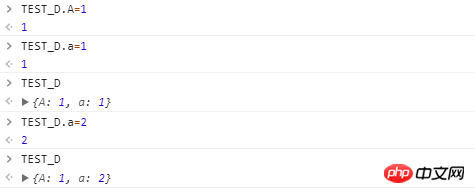
When you continue to add the a attribute after deletion, a becomes changeable again. The above just changes the writable attribute of the a attribute, and there is also a configurable attribute that can be set. The writable attribute only changes the corresponding attribute so that it cannot be changed directly, but it can be done in a small way (delete first and then add).
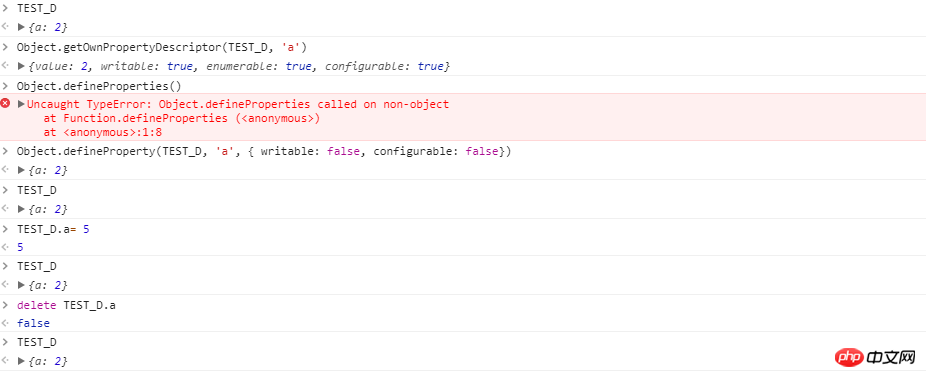
# Even if attribute a is finalized, it cannot be modified or deleted.
However, a new storm has emerged. . . Although a has been decided, it is not over yet for the variable TEST_D. . .

Although attribute a cannot be changed, it does not affect the operation of other attributes, such as b, s, u. Of course, these attributes can also be used as above. The descriptors of other attributes are also used, but the extension to TEST_D still cannot be solved.
2) Object.preventExtensions: This method makes an object non-extensible, that is, new properties can never be added. View details
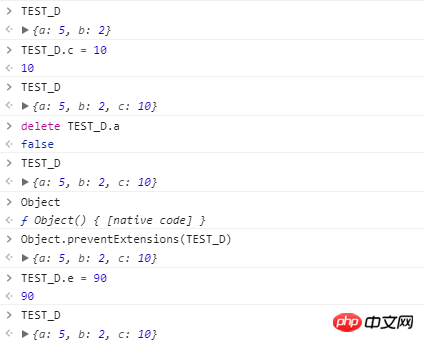
# Through this method, the object can be set to be non-expandable, that is, new attributes cannot be added, so this variable cannot be modified.
3) Object.seal: Let an object be sealed and return the sealed object. The new object will become non-extensible, that is, new properties cannot be added but properties that were originally writable can be modified
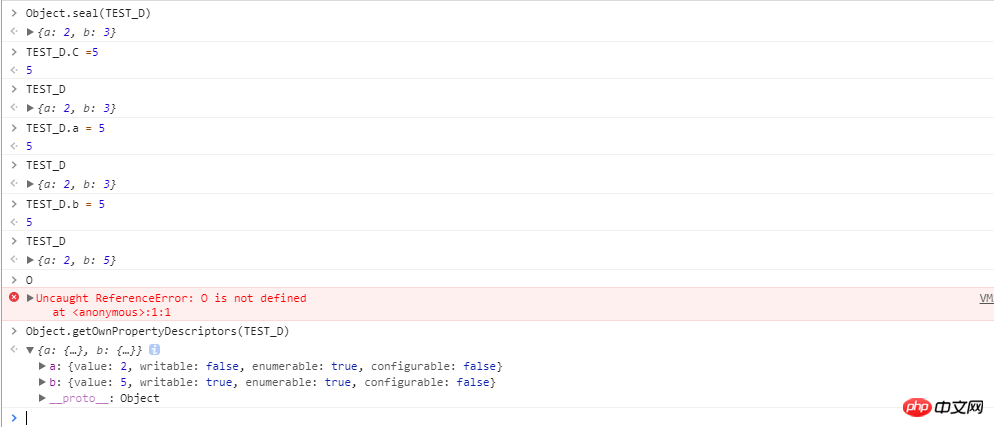
It is possible to create constants by using the above two methods in a loop, but it is more complicated, and when the object is relatively large, the amount of code will be relatively large. Object.seal() can simplify this process. This method can make the object non-extensible and the properties cannot be deleted. On this basis, by changing the descriptors of all properties of the object from writable to false, we can get the variables we want, which are so-called constants.
4) Object.freeze: This method can freeze an object. Freezing means that new attributes cannot be added to the object, the values of existing attributes cannot be modified, existing attributes cannot be deleted, and cannot be modified. The object has enumerability, configurability, and writability properties. In other words, this object is always immutable. This method returns the frozen object.
The Object.freeze method is based on seal and changes the descriptor writable of all properties to false.
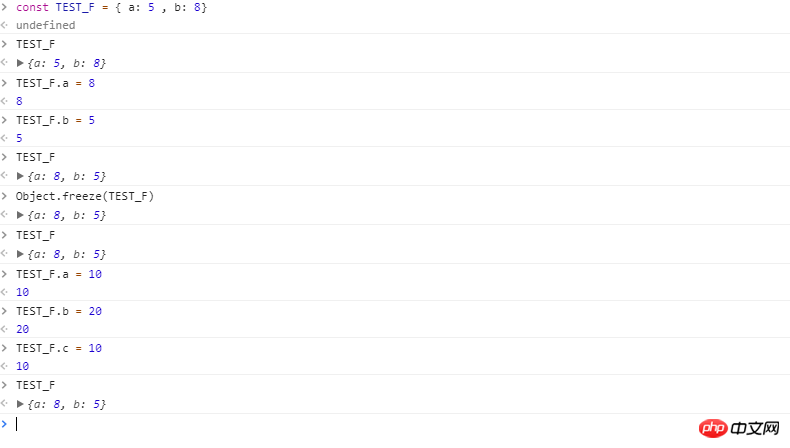
But when the attribute value of the variable is an object, and the following situations:
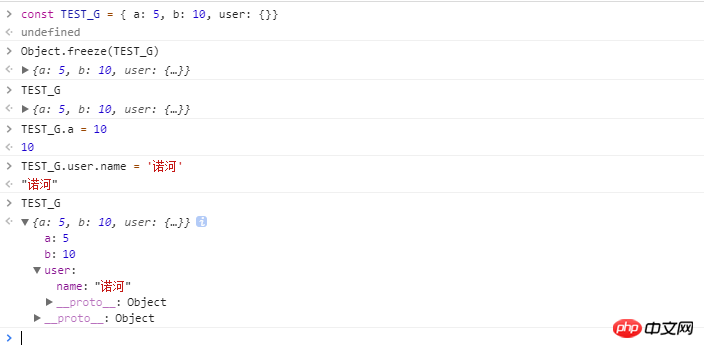
For the user attribute , its value can still be changed, and it must be frozen at this time.
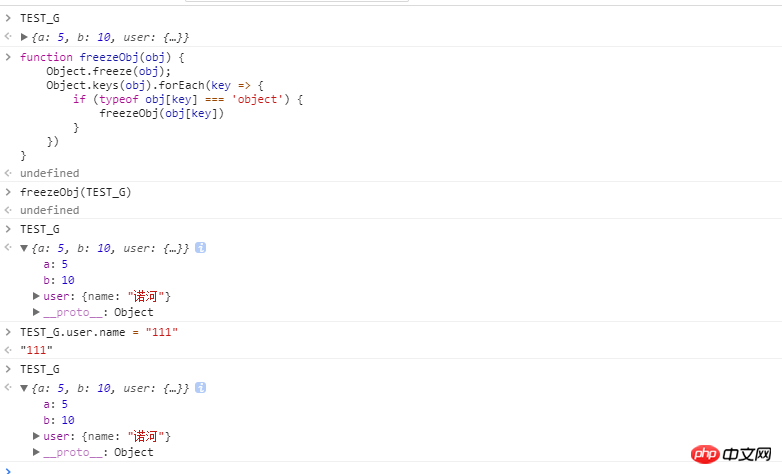
/**
*
*
* @param {any} obj
*/
function freezeObj(obj) {
Object.freeze(obj);
Object.keys(obj).forEach(key => {
if (typeof obj[key] === 'object') {
freezeObj(obj[key])
}
})
}That is: when there are multiple objects, the freezing method needs to be called cyclically.
3: Closure
const USER = (() => {
const USER = {
name: 'evening',
gender: 'M'
}
return {
get(name){
return user[name]
}
}
})()
USER.get('name')The closure uses a relatively secret method to save the real object prototype in the memory and will not be recycled, thus 'protecting' the USER variable in disguise up, and provides an access interface, but does not provide an interface for modification.
The above is what I compiled for everyone. I hope it will be helpful to everyone in the future.
Related articles:
How to change the avatar in node
How to use the Generator method in JavaScript
404 problem occurs when refreshing the page in react-router
Details introduction to the use of Vue event modifier capture
The above is the detailed content of About creating constants in JavaScript (detailed tutorial). For more information, please follow other related articles on the PHP Chinese website!

Hot AI Tools

Undresser.AI Undress
AI-powered app for creating realistic nude photos

AI Clothes Remover
Online AI tool for removing clothes from photos.

Undress AI Tool
Undress images for free

Clothoff.io
AI clothes remover

Video Face Swap
Swap faces in any video effortlessly with our completely free AI face swap tool!

Hot Article

Hot Tools

Notepad++7.3.1
Easy-to-use and free code editor

SublimeText3 Chinese version
Chinese version, very easy to use

Zend Studio 13.0.1
Powerful PHP integrated development environment

Dreamweaver CS6
Visual web development tools

SublimeText3 Mac version
God-level code editing software (SublimeText3)

Hot Topics
 1657
1657
 14
14
 1415
1415
 52
52
 1309
1309
 25
25
 1257
1257
 29
29
 1229
1229
 24
24
 Demystifying JavaScript: What It Does and Why It Matters
Apr 09, 2025 am 12:07 AM
Demystifying JavaScript: What It Does and Why It Matters
Apr 09, 2025 am 12:07 AM
JavaScript is the cornerstone of modern web development, and its main functions include event-driven programming, dynamic content generation and asynchronous programming. 1) Event-driven programming allows web pages to change dynamically according to user operations. 2) Dynamic content generation allows page content to be adjusted according to conditions. 3) Asynchronous programming ensures that the user interface is not blocked. JavaScript is widely used in web interaction, single-page application and server-side development, greatly improving the flexibility of user experience and cross-platform development.
 The Evolution of JavaScript: Current Trends and Future Prospects
Apr 10, 2025 am 09:33 AM
The Evolution of JavaScript: Current Trends and Future Prospects
Apr 10, 2025 am 09:33 AM
The latest trends in JavaScript include the rise of TypeScript, the popularity of modern frameworks and libraries, and the application of WebAssembly. Future prospects cover more powerful type systems, the development of server-side JavaScript, the expansion of artificial intelligence and machine learning, and the potential of IoT and edge computing.
 JavaScript Engines: Comparing Implementations
Apr 13, 2025 am 12:05 AM
JavaScript Engines: Comparing Implementations
Apr 13, 2025 am 12:05 AM
Different JavaScript engines have different effects when parsing and executing JavaScript code, because the implementation principles and optimization strategies of each engine differ. 1. Lexical analysis: convert source code into lexical unit. 2. Grammar analysis: Generate an abstract syntax tree. 3. Optimization and compilation: Generate machine code through the JIT compiler. 4. Execute: Run the machine code. V8 engine optimizes through instant compilation and hidden class, SpiderMonkey uses a type inference system, resulting in different performance performance on the same code.
 JavaScript: Exploring the Versatility of a Web Language
Apr 11, 2025 am 12:01 AM
JavaScript: Exploring the Versatility of a Web Language
Apr 11, 2025 am 12:01 AM
JavaScript is the core language of modern web development and is widely used for its diversity and flexibility. 1) Front-end development: build dynamic web pages and single-page applications through DOM operations and modern frameworks (such as React, Vue.js, Angular). 2) Server-side development: Node.js uses a non-blocking I/O model to handle high concurrency and real-time applications. 3) Mobile and desktop application development: cross-platform development is realized through ReactNative and Electron to improve development efficiency.
 Python vs. JavaScript: The Learning Curve and Ease of Use
Apr 16, 2025 am 12:12 AM
Python vs. JavaScript: The Learning Curve and Ease of Use
Apr 16, 2025 am 12:12 AM
Python is more suitable for beginners, with a smooth learning curve and concise syntax; JavaScript is suitable for front-end development, with a steep learning curve and flexible syntax. 1. Python syntax is intuitive and suitable for data science and back-end development. 2. JavaScript is flexible and widely used in front-end and server-side programming.
 How to Build a Multi-Tenant SaaS Application with Next.js (Frontend Integration)
Apr 11, 2025 am 08:22 AM
How to Build a Multi-Tenant SaaS Application with Next.js (Frontend Integration)
Apr 11, 2025 am 08:22 AM
This article demonstrates frontend integration with a backend secured by Permit, building a functional EdTech SaaS application using Next.js. The frontend fetches user permissions to control UI visibility and ensures API requests adhere to role-base
 From C/C to JavaScript: How It All Works
Apr 14, 2025 am 12:05 AM
From C/C to JavaScript: How It All Works
Apr 14, 2025 am 12:05 AM
The shift from C/C to JavaScript requires adapting to dynamic typing, garbage collection and asynchronous programming. 1) C/C is a statically typed language that requires manual memory management, while JavaScript is dynamically typed and garbage collection is automatically processed. 2) C/C needs to be compiled into machine code, while JavaScript is an interpreted language. 3) JavaScript introduces concepts such as closures, prototype chains and Promise, which enhances flexibility and asynchronous programming capabilities.
 How do I install JavaScript?
Apr 05, 2025 am 12:16 AM
How do I install JavaScript?
Apr 05, 2025 am 12:16 AM
JavaScript does not require installation because it is already built into modern browsers. You just need a text editor and a browser to get started. 1) In the browser environment, run it by embedding the HTML file through tags. 2) In the Node.js environment, after downloading and installing Node.js, run the JavaScript file through the command line.




